Henley
Henley
I'm back.
During the hiatus made some progress on the fictional "Henley," which I will add in haste bears no semblance of the real Henley. Henley, or more precisely Shiplake, is where my family resided in '66 - '67, and it left indelible impressions of cobblestones, fog, rolling green hills, the savory scent of scones and diesel fumes from double deck buses. friendly people and trains. British trains, where at the venerable age of six I received a Wrenn wind up and was hooked for life. We traveled by train; endless miles of Devonshire countryside from the window of a dining coach, Yorkshire Pudding, the clank of wheel on joint, and the sway of footplates in the vestibule. A child's paradise.
'
Upon a 4 x 8 slab, I endeavor to recreate more a feeling of the place than a replication. As an adult, the history, prehistory, and mythology of Greater Britain is an endless fascination, for I know of no other spot on the globe where such a nexus of culture and artifact intersect with such concentration. Fop example, a fellow digging in his back yard to install some sort of water line unearths a beautiful Roman mosaic. A grounds man tending a cricket pitch unearths a hoard. Loch Ness Monster. Sutton Hoo. Stone Henge, Norman castles and knights in armor. The range and depth is unequaled anywhere else. All this in good fun; never cynical.
To add cohesion to the carnival of events, I decided upon the year 1927, in part from having read Bill Bryson extensively, and his sensational narrative of events in the U.S. of 1927. That, and locomotives circulating in the Edwardian age are like iron dinosauria in their morphology, shaped by the forces of the need for speed, power, utility and efficiency.
But the roaring Deltics of the '60's make the occasional appearance: I run a '60's era rake sometimes, amidst the Edwardian country side and passenger livery, to emulate a "Steam Preservation" day. The Norman(ish) castle is replete with jousting knights and nobility, as a a scene of medieval recreation by modern day re-enactors. There is a large horse farm, there, also, where my beloved sister took her riding lessons. I like my cake, and to eat it too.
In addition to the usual stills, I like to video tape short episodes of the trains in operation, perhaps a little influenced by Thomas, et al, but with more of a bent towards Monty Python than Ringo Starr. It's all about the nostalgia of a brief British childhood, and many happy memories therein.
Mod note Topic moved to the Members layout section from the Welcome area.
During the hiatus made some progress on the fictional "Henley," which I will add in haste bears no semblance of the real Henley. Henley, or more precisely Shiplake, is where my family resided in '66 - '67, and it left indelible impressions of cobblestones, fog, rolling green hills, the savory scent of scones and diesel fumes from double deck buses. friendly people and trains. British trains, where at the venerable age of six I received a Wrenn wind up and was hooked for life. We traveled by train; endless miles of Devonshire countryside from the window of a dining coach, Yorkshire Pudding, the clank of wheel on joint, and the sway of footplates in the vestibule. A child's paradise.
'
Upon a 4 x 8 slab, I endeavor to recreate more a feeling of the place than a replication. As an adult, the history, prehistory, and mythology of Greater Britain is an endless fascination, for I know of no other spot on the globe where such a nexus of culture and artifact intersect with such concentration. Fop example, a fellow digging in his back yard to install some sort of water line unearths a beautiful Roman mosaic. A grounds man tending a cricket pitch unearths a hoard. Loch Ness Monster. Sutton Hoo. Stone Henge, Norman castles and knights in armor. The range and depth is unequaled anywhere else. All this in good fun; never cynical.
To add cohesion to the carnival of events, I decided upon the year 1927, in part from having read Bill Bryson extensively, and his sensational narrative of events in the U.S. of 1927. That, and locomotives circulating in the Edwardian age are like iron dinosauria in their morphology, shaped by the forces of the need for speed, power, utility and efficiency.
But the roaring Deltics of the '60's make the occasional appearance: I run a '60's era rake sometimes, amidst the Edwardian country side and passenger livery, to emulate a "Steam Preservation" day. The Norman(ish) castle is replete with jousting knights and nobility, as a a scene of medieval recreation by modern day re-enactors. There is a large horse farm, there, also, where my beloved sister took her riding lessons. I like my cake, and to eat it too.
In addition to the usual stills, I like to video tape short episodes of the trains in operation, perhaps a little influenced by Thomas, et al, but with more of a bent towards Monty Python than Ringo Starr. It's all about the nostalgia of a brief British childhood, and many happy memories therein.
Mod note Topic moved to the Members layout section from the Welcome area.
Steam Preservation in Henley
https://www.youtube.com/watch?v=qv4uRvExzWU
From the Loch Ness Monster to the Dragon of St. George, Henley has it all.
From the Loch Ness Monster to the Dragon of St. George, Henley has it all.
Henley Colliery Gets a DMU
No longer do the miners have to trudge from Village Henley to the colliery. Now they can ride in style. Thank you, Sandy, for making it possible.
https://www.youtube.com/watch?v=mkmyFDKUXS8
https://www.youtube.com/watch?v=mkmyFDKUXS8
-
Mountain Goat
- Posts: 1537
- Joined: Fri Oct 05, 2018 12:57 pm
- Contact:
Re: Henley
Those Great Western Railway 1930's railcars were designed to pick up passengers both at standard UK platform height and half height which was at floor level. Most Great Western Railway halts were at ground level with some larger halts being half standard platform helight level, and the GWR autocoaches, the GWR railcars and a few of the coaches designed for branchline use were built to accomodate ground level halts as well as the usual UK "Normal" platform height stations. Normal is an average as this varied quite a bit which limits some modern trains from using some lines. Two stations on the "Central" (Heart Of Wales Line) are too high to allow class 158's to open their doors so class 158's, 159's and others that have outward opening air powered doors can't be used on that line. All ground level halts were abandoned in the Beeching years of British Railways as the cost of raising their height to make them standard was not worth the cost compared to the amount of passenger use they would get. They only made them ground level in the first place as so few passeners would use them but they ran those autotrains or railcars (Steam railcars before the diesels) specifically to add any revenue they could find which is why some of these ground level halts were opened as late as the 1930's, as during that decade the railways had to grasp every penny they could as the UK was in a recession. The standard raised platform height was origionally introduced in the UK to aid the easy loading and unloading of goods. Origional early platforms had no platform ramps but after accidents early in the railway age of development, new rules were put in that all platforms had to have ramps, so certainly by the late 1840's to the 1850's nearly all passenger platforms of a standard or a half height had ramps, with the very rare exceptions of the rare few which were built before that date, and even then most were converted. Was only the earliest few which happened to have a building such as a signalbox at the end they did not add a ramp. After the rules came in a platform would have a ramp before it reached a signalbox or other building with the exception of plaftorm mounted signalboxes and other buildings which had to have a certain space between the platform edge and the building.
Is fascinating as many stations can be dated if they predated certain railway rules, so if one sees an old station and there is a rule breaking feature, it was built before the rule came into play so one has an idea of when it was built.
Is fascinating as many stations can be dated if they predated certain railway rules, so if one sees an old station and there is a rule breaking feature, it was built before the rule came into play so one has an idea of when it was built.
Budget modelling in 0-16.5...
Coal Board Strikes: DMU Remains
It was brought to my attention that the GWR would never have assigned the upscale streamline DMU of 1933 to colliery service. Ergo, it was necessary to come up with a fictional cover story. 
https://www.youtube.com/watch?v=p8WOoOGUr5M
https://www.youtube.com/watch?v=p8WOoOGUr5M
Henley Gets a Goods Yard
Initial progress: a disused module baseboard from my train club days was retrieved from the garden and put to good use. It slotted right in as if it was purpose built. The canal scene, which had to be moved, equally slotted right in on the vacant spot to its left. The scratch built paper retaining wall (an iconic British item plagiarized shamelessly, again slotted right in to give a transition from water to rail. Bachmann EZ track is used, and the plastic sheen is slated for a toning down in months to come. Many pleasurable hours of scenic work to come; this is a rough edit.
Bachann EZ track was not an obvious choice, but for my limited abilities it is ideal. It works right out of the box, it prevents me from getting overboard with too many turnouts and sharp radii in too little space, and requires minimal tuning. I am not committed to complicated and messy ballasting, and if I get a better idea, it can be lifted right out. It is heavy, and requires no additional securement. There are, perhaps, better European brands that do the same thing, but the cost is frightful.
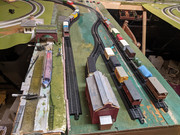
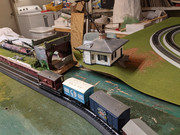
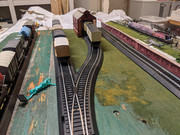


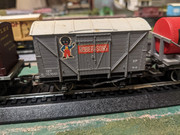
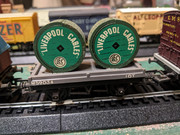
The Grand Terminus, under construction. Someone sent me some modern platforms, so in a wink I can lift out the scratch built paper platforms and drop in the modern concrete ones and go from 1867 to 1967.
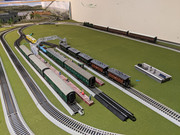
Bachann EZ track was not an obvious choice, but for my limited abilities it is ideal. It works right out of the box, it prevents me from getting overboard with too many turnouts and sharp radii in too little space, and requires minimal tuning. I am not committed to complicated and messy ballasting, and if I get a better idea, it can be lifted right out. It is heavy, and requires no additional securement. There are, perhaps, better European brands that do the same thing, but the cost is frightful.







The Grand Terminus, under construction. Someone sent me some modern platforms, so in a wink I can lift out the scratch built paper platforms and drop in the modern concrete ones and go from 1867 to 1967.

-
Mountain Goat
- Posts: 1537
- Joined: Fri Oct 05, 2018 12:57 pm
- Contact:
Re: Henley
You are having great success with your track. The good thing is that it is easy to lift and put back down again from the looks of it.
Budget modelling in 0-16.5...
Re: Henley
Thank you, Mr. Goat. The EZ track has been a blessing for its reliability and ease of installation that permits me to "shoot from the hip," whilst still permitting me to get a little creative without going overboard. My latest project is painting a dilute wash of India Ink upon the roadbed to dull the plastic shine. Not quite as dark as I would like, but think I will quit whilst ahead, so as not to bollock the job. The water based in clings quite tightly to the plastic, to my surprise, so it is necessary to paint a little, allow it to set for a few minutes, then wipe off the excess with a paper towel. Slow going, but it should look a bit better once the surrounding landscape is built up a little with "grass.
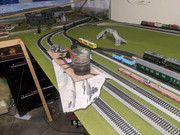
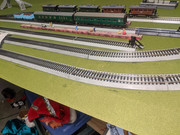


Re: Henley
Building up the surface of the Goods Yard using double layer of discarded cardboard. Over this will be an application of "brick" paper, to give it an industrial look. Frankly, I have absolutely no idea if this was typical, or atypical, British practice. Perhaps I've gleaned it from some of the better entries herein. Well, I like it. Reminds me a bit of the grim Birmingham quayside in "Peaky Blinders." (That, by the way, has a most intriguing method of shooting color upon a largely black and gray scene. Marvelous trick, that).
Canal scene is in the upper left, and seeing this from a new angle I believe I shall extend the canal out a bit. I don't believe I will be adding British gangsters blasting away at one another. We already have plenty of that, on this side of the pond.
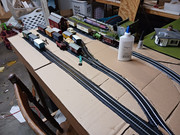
Canal scene is in the upper left, and seeing this from a new angle I believe I shall extend the canal out a bit. I don't believe I will be adding British gangsters blasting away at one another. We already have plenty of that, on this side of the pond.

Re: Goods Yard Coming Along
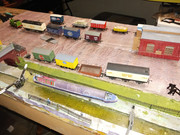
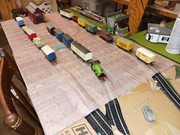
After the glue dries, the rail heads will be exposed, the inlays cemented in place. Same treatment for the collier, but the brick paving stones are all in gray and black, as seems to be the case from what images I've gleaned.

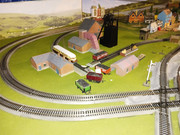
Who is online
Users browsing this forum: Google [Bot] and 1 guest